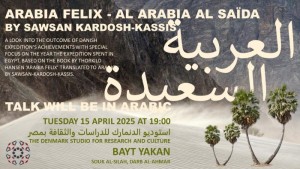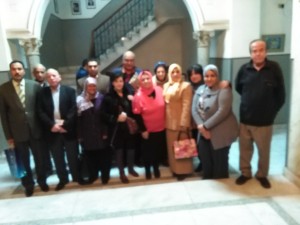Ahram Weekly
Al-Bashmouri II, Salwa Bakr, Cairo: Supreme Council of Culture. 2000, pp151
Reviewed by Mahmoud El-Wardani
Salwa Bakr published the first part of Al-Bashmouri, her historical novel, two years ago, and in Al-Bashmouri II, the long-awaited second part, she follows the journey of her protagonist, the Coptic Christian Bedeir, from Egypt to Iraq and his eventual return five years later via Jerusalem. There seems little doubt that in certain respects the present novel fails where the previous one had succeeded, but Al-Bashmouri II remains, nevertheless, an engaging historical narrative.
In her first part, the action of which took place during the Abbassid period when members of this religious dynasty controlled a vast Islamic empire in the Middle East and North Africa, Bakr had tackled the hidden record of the "Bashmouri Revolt" during which the Coptic residents of the Egyptian Nile Delta fought back against their Abbassid overlords in Iraq. Religion, and the Christian community's minority status within the empire, was not at issue in this revolt; rather the Copts were protesting against the conditions of dire poverty in which they lived. The Bashmouri Revolt is an event in mediaeval history that has received comparatively little comment and, employing what she called "a narrative of narratives", Bakr managed to mould a tightly constructed text around it that relied on the narratives of historians and eyewitnesses from the period.
The great virtue of this method was that it allowed the novelist to exploit to the full ironies and missing links in her source materials, thus enabling her to reconstruct the narrative space in which she herself functions as a novelist. Al-Bashmouri was an impressively multi-faceted book that transcended the limitations of the conventional "historical novel" and could be read at a variety of social, cultural and intellectual levels. It ended with the Abbassid Caliph Al-Mahdi's brutal crushing of the revolt, and the deportation of the population to Iraq. The book showed how this Christian community lost all contact with its homeland, and thus ended on a note of tragic exile.
However in the present second part of her novel, which is intended to continue the story from this point, Bakr, instead of skillfully exploiting her source materials for maximum effect as she had done in her first part, rather falls prey to them. She lets them take over the book and does not go far enough to mould these materials into an effective new text of her own creation -- something which cannot but fail to lead the reader to the conclusion that the second part of Al-Bashmouri is an unnecessary addition to an already complete and powerful text. Here the writer has given up the task of creating a true "narrative of narratives" and has instead produced more of a "muddle of narratives," or narrative muddle, frequently losing the thread of her own contribution. Extracts from the various mediaeval digests of the names of plants, perfumes and animals, which she reproduces verbatim, for example, do little more than communicate the author's own whimsical fascination with largely irrelevant historical information.
There is also Bedeir's conversion to Islam to be contended with. Unjustified from a literary point of view, this is but a further example of the ever-present, yet somewhat naive, idea that Bakr reiterates throughout the book and overemphasises in its last few pages, namely that, regardless of the specific rituals and precepts of each religion, the purpose of all religions is the same whichever creed is professed. People should live peacefully in a tolerant and just society free from exploitation and abuse. Is that finally all that the novel can find to say? There are also other, local problems that threaten the reader's necessary suspension of disbelief. Why should Bedeir, having burned his hands upon seeing the beautiful slave girl Rita, leave at once when she is given to him by the caliph? Why the puritanism? It seems that too often in Al-Bashmouri II the author has allowed herself to introduce interpolations to the text that, while allowing her to indulge her love of physical and historical detail (for example the extended descriptions of the caliph's palace and the life of the palace dervishes), do little to advance her narrative project or convince the reader of its value. This seems a pity, given the very evident success of the novel's striking first part.
Novel of novels
فعاليات

الجليد لصنع الله ابراهيم
يونيو 26, 2025
شاركنا في ندوة ينظمها المنتدى لمناقشة رواية الجليد...

العربية السعيدة في بيت يكن
إبريل 15, 2025
العربية السعيدة، لتوركل هانسن وترجمة سوسن كردوش قس...

الأديب: رؤية ومسيرة ... حوار مع إيلان بابيه عبر زووم
مارس 15, 2025
تمت هذه الحلقة في 15 مارس 2025 ، تستطيع الان مشاهد...

مسافر يبحث عن ماء
فبراير 17, 2025
تقيم نقابة اتحاد كتاب مصرشعبة أدب الرحلات تحت رعاي...
